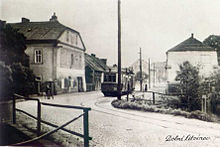Dolní Litvínov
| Dolní Litvínov | ||||
|---|---|---|---|---|
|
||||
| Basic data | ||||
| State : |
|
|||
| Region : | Ústecký kraj | |||
| District : | Must | |||
| Municipality : | Litvínov | |||
| Area : | 515.3178 ha | |||
| Geographic location : | 50 ° 35 ' N , 13 ° 36' E | |||
| Height: | 290 m nm | |||
| Residents : | 58 (2011) | |||
| Postal code : | 436 91 | |||
| License plate : | U | |||
| traffic | ||||
| Street: | Litvínov - must | |||
Dolní Litvínov ( German Nieder Leutensdorf also Niederleutensdorf ) is a district of Litvínov in the Czech Republic .
geography
Dolní Litvínov is one and a half kilometers south of Horní Litvínov and was almost completely devastated in the late 1950s. The location extended along the stream Bílý potok (Weißbach , formerly the Gold River) in the North Bohemian Basin . The Wieseberg (313 m) rises to the east.
Neighboring towns were Horní Litvínov in the north, Lom in the northeast, Louka u Litvínova in the east, Libkovice , Mariánské Radčice , Konobrže and Lipětín in the southeast, Souš in the south, Záluží in the southwest, Horní Jiřetín in the west and Hamr and Chudeřín in the northwest.
history
The first written mention of the Lehngut Niderleutmansdorf belonging to the giant castle was in 1398 as the property of Peter and Hans Groß. In the same year the brothers Borso d. Ä. and Borso d. J. von Riesenburg passed the rule of Riesenburg to Margrave Wilhelm I of Meissen . In the Treaty of Eger from 1459, by which the rule Riesenburg back part was the Kingdom of Bohemia, both Nedir Leutnnansdorf and Leutmannsdorf listed. Both feudal estates were then handed over by King George of Podiebrad to people whose name has not been passed down.
From 1515 the estate belonged to the knights Schön of Schönau (Šén ze Šénu) ; with the death of Christoph Schön von Schönau, the family died out in 1572. In 1580 Nikolaus Hieserle von Chodow (Mikuláš Hýzrle z Chodů) was mentioned as the owner. Shortly afterwards the lords of Lobkowicz bought the estate and united it with Niedergeorgenthal . In 1608 they added both estates together with Oberleutensdorf to the Dux lordship . 1618 is said to have been a fortress in the place. In 1642 the Counts of Waldstein inherited the rule. In 1680 Johann Friedrich von Waldstein raised the lordships of Dux and Oberleutensdorf to a family affide . In the first half of the 18th century, 21 farmers, two shoemakers, a carpenter and a tailor lived in the agricultural town. In 1787 Nieder-Leitensdorf consisted of 47 houses. In Czech, the village was referred to as Doleynij Litwinov , Doleyssi litwinow and Dolnij Litwinow .
In 1831 Nieder-Leitensdorf consisted of 52 houses with 248 German-speaking residents, including 19 traders. In the village there was an official farm , a sheep farm, a hunting arsenal, a potash boiler , a forester's house, two grinding mills and a paper mill . Parish was Ober-Leitensdorf . Until the middle of the 19th century, Nieder-Leitensdorf remained subject to the Fideikommissherrschaft Dux with Ober-Leitensdorf.
After the abolition of patrimonial made low-Leutensdorf 1850 with the districts Lindau and Maltheyr a municipality in Leitmeritzer county and judicial district Brüx. Maltheyr became independent in 1862. From 1868 the community belonged to the district of Brüx . In 1876, traffic on the Brüx – Ossegg railway was started. As a result of industrialization and increasing lignite mining, the region saw a sharp increase in population in the second half of the 19th century; a large part of the workers who moved there were Czechs. Many residents worked in the textile factories in Oberleutensdorf or in the Tegetthoff collieries near Maltheuern and Pluto near Wiese. In 1901 tram traffic between Brüx and Johnsdorf was started. From 1905 the community belonged to the newly formed court district Oberleutensdorf. As a result of the Munich Agreement , the municipality was added to the German Reich in 1938 and belonged to the district of Brüx until 1945 . As a result of the emigration of many Czechs, the number of inhabitants had decreased to 2177 in 1939. In 1941 Niederleutensdorf was incorporated with Lindau to Oberleutensdorf. After the end of World War II, Dolní Litvínov returned to Czechoslovakia and the German-Bohemian population was expelled . The incorporation after Horní Litvínov was canceled again in mid-1945; The new incorporation took place just two years later.
After the renaming of the town Horní Litvínov to Litvínov, the district was initially named Litvínov II . In the course of coal mining, Dolní Litvínov was largely liquidated together with Lipětín and Růžodol between 1957 and 1959 .
Development of the population
|
|
|
Web links
Individual evidence
- ↑ http://www.uir.cz/katastralni-uzemi/686131/Dolni-Litvinov
- ↑ a b Historický lexikon obcí České republiky - 1869–2015. (PDF) Český statistický úřad, December 18, 2015, accessed on February 17, 2016 (Czech).
- ^ Johann Gottfried Sommer: The Kingdom of Bohemia, Vol. 1: Leitmeritzer circle. 1833, p. 144
- ^ Michael Rademacher: German administrative history from the unification of the empire in 1871 to the reunification in 1990. District of Brüx (Czech. Most). (Online material for the dissertation, Osnabrück 2006).



